The multi-layer framework provides a new perspective for chain abstraction, classifying solutions based on their impact on user experience in the Web3 ecosystem.
Authors: Carlos Maximiliano Cano, Ethan Francis
Translation: Deep Tide TechFlow
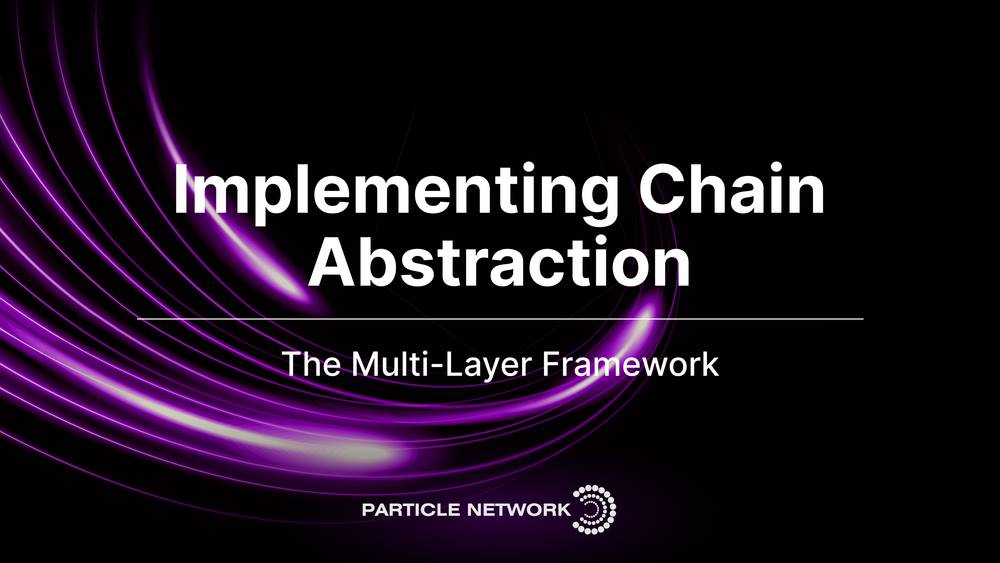
Chain abstraction can only be achieved through multi-layer technology.
As this field continues to evolve, it is becoming increasingly clear that chain abstraction is a multifaceted approach aimed at simplifying the user experience of decentralized ecosystems, rather than just a technology. This has been clearly demonstrated in multiple projects that attempt to implement chain abstraction in different Web3 applications and infrastructures.
Within the theoretical framework of this new field, various methods have emerged for understanding the roles and participation of chain abstraction participants. This article will formally introduce a multi-layer framework. This framework was first proposed in the article "Chain Abstraction Levels: Diversifying User Experience in Web3 Evolution", aiming to understand the chain abstraction ecosystem through the roles of different services and products in user experience.
Multi-layer framework: Objectives and Importance
The objective of establishing a multi-layer framework for chain abstraction is to provide a structured and comprehensive approach to understanding the various paths for implementing chain abstraction experiences. It also aims to demonstrate that chain abstraction, as a stack of multi-layer technologies, can achieve "comprehensive implementation" of chain abstraction—covering all experiences that users may encounter in Web3.
Importantly, the multi-layer framework relies on the previously proposed formal definition of chain abstraction (ChA), describing ChA as "the user experience of interacting with multiple chains without manual operations." This definition is crucial for the framework itself, as understanding chain abstraction as an experience is essential for better categorizing the participants. This experience may or may not occur in users' different Web3 interactions, and various solutions work together to achieve complete implementation.
Therefore, this framework considers the following:
How various solutions abstract the complexity of interacting with multiple chains from the user experience.
How different components and solutions work together in a modular and complementary manner to create a seamless unified chain abstraction user experience across multiple blockchains.
The natural evolution of diverse chain abstraction solutions, each of which meets the different practical needs of users and developers.
Introduction to the Multi-layer Framework
This framework consists of three levels, each of which implements the chain abstraction experience through various possible user activities and existing experiences. To be classified within this multi-layer chain abstraction framework, a project or solution must aim to address one or more aspects of the user experience across multiple blockchains. The specific inclusion criteria are as follows:
Solutions should aim to simplify interactions and workflows for users and developers across different chains.
Solutions should provide tangible benefits to the user experience, regardless of their target level. Therefore, solutions that only partially implement chain abstraction but are valuable for implementing chain abstraction may be more suitable for other frameworks, which will be discussed later.
After clarifying our basic rules, the framework itself categorizes projects as follows:
Application Layer Chain Abstraction (Orchestration)
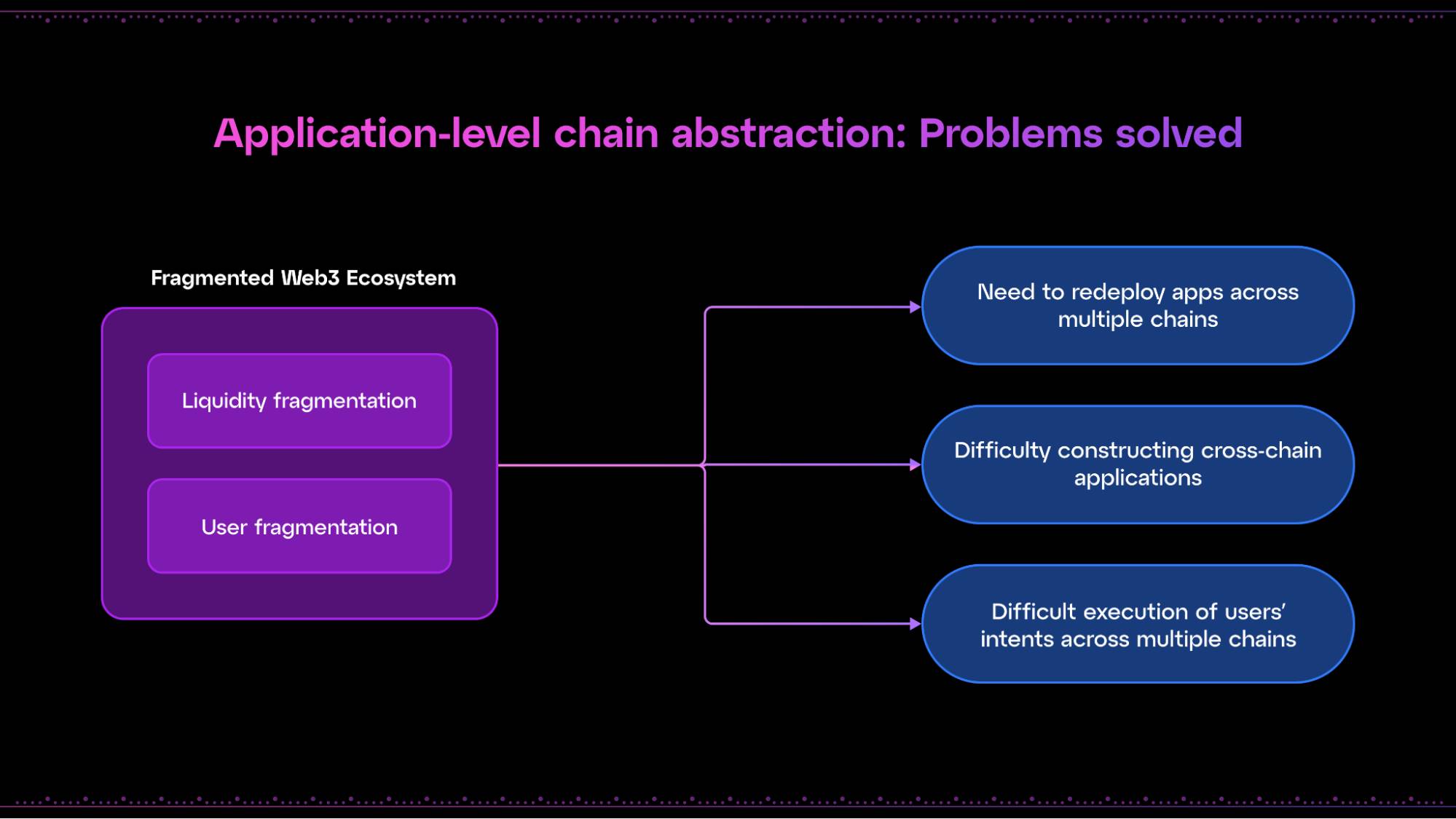
The application layer, also known as the orchestration layer, focuses on empowering developers to create decentralized applications (dApps) that can seamlessly operate and interact across multiple blockchains. This layer includes:
Low-level software development kits (SDKs) and application programming interfaces (APIs) for orchestrating cross-chain workflows and operations in dApps.
Frameworks for building chain-agnostic applications.
Solvers and intent networks that translate user goals into multi-chain paths, implemented through the SDKs at the application layer.
By providing these developer-centric tools and abstractions, the application layer achieves:
Creation of applications that can coordinate and execute transactions across different chains through a single user-level signature.
Implementation of asynchronous, long-running business logic across multiple blockchains, enhancing the interoperability and flexibility of dApps.
Abstraction of the underlying multi-chain complexity, enabling developers to focus on application-specific functionality.
The application layer is considered a necessary condition for achieving the complete chain abstraction experience, as it complements the account layer solutions by extending the abstraction capabilities of applications that users care about.
Projects such as Agoric, Skip, and Socket are at the forefront of application layer chain abstraction, providing developers with the tools and frameworks needed to build truly chain-agnostic applications. For example:
Agoric's orchestration API provides contracts and APIs for executing multi-chain transaction processes, simplifying complex interoperability operations through a single user signature.
Skip offers an API to facilitate seamless cross-chain transactions (exchanges, transfers, etc.), aggregating messaging protocols such as IBC, Hyperlane, and Axelar.
Socket provides an open intent execution and settlement market, allowing developers to compose with any application and asset.
By leveraging these solutions, developers can focus on creating innovative user experiences without being restricted by multiple blockchain networks, thus contributing to the broader goals of chain abstraction at the application layer.
Account Layer Chain Abstraction
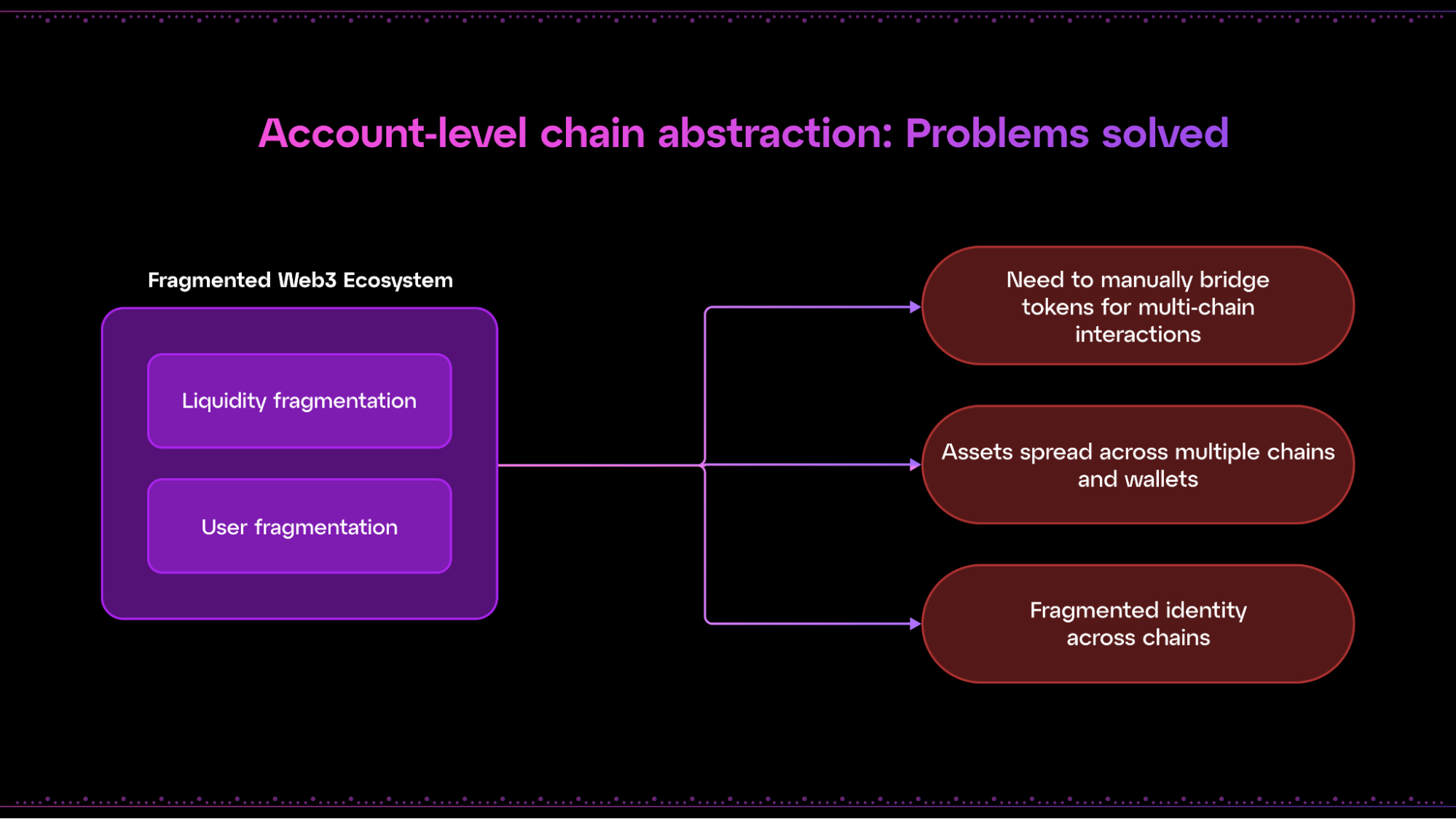
The account layer aims to provide users with a universal mechanism for seamless interaction across multiple chains, addressing the fragmentation issues at the user level. It involves directly providing users with a method to achieve a single balance across multiple chains, enabling users to deploy assets in the Web3 ecosystem without manually managing multiple chains. This layer includes:
Universal methods for cross-chain and application balance.
Automation of gas payments and account interactions challenges across multiple chains at the account layer.
Providing a unified technology for a single identity or access point across multiple chains.
By unifying the account experience, the account layer achieves:
Consistent identity and balance for users across participating chains.
Transparent and seamless movement of assets across different blockchains.
A chain-agnostic user experience where the underlying blockchains become irrelevant and optional details.
This layer is crucial for achieving complete chain abstraction implementation, as it significantly enhances the user experience by abstracting the need to manage separate accounts and asset pools for each individual chain. This seamless integration at the account layer complements the infrastructure provided by the other two layers, further promoting efficient and user-friendly interactions in the Web3 ecosystem.
Examples of account layer chain abstraction solutions include:
Particle Network provides Universal Accounts to offer users a unified address and balance across chains.
XION offers a chain abstraction solution aimed at eliminating complexity for all end users through various abstractions (accounts, signatures, gas, devices, etc.). This is extended through Meta Accounts, allowing centralized control of assets and accounts on external chains using XION L1.
NEAR provides chain signatures, allowing centralized control of accounts across chains on NEAR.
OneBalance offers a low-level primitive for "resource locking" through trusted accounts, supporting functions such as balance unification and gas abstraction.
By providing a consistent and unified account experience, the account layer serves as an important step in implementing complete chain abstraction, enabling all users to use Web3 applications and services without concern for the underlying blockchain infrastructure.
Blockchain Layer Chain Abstraction
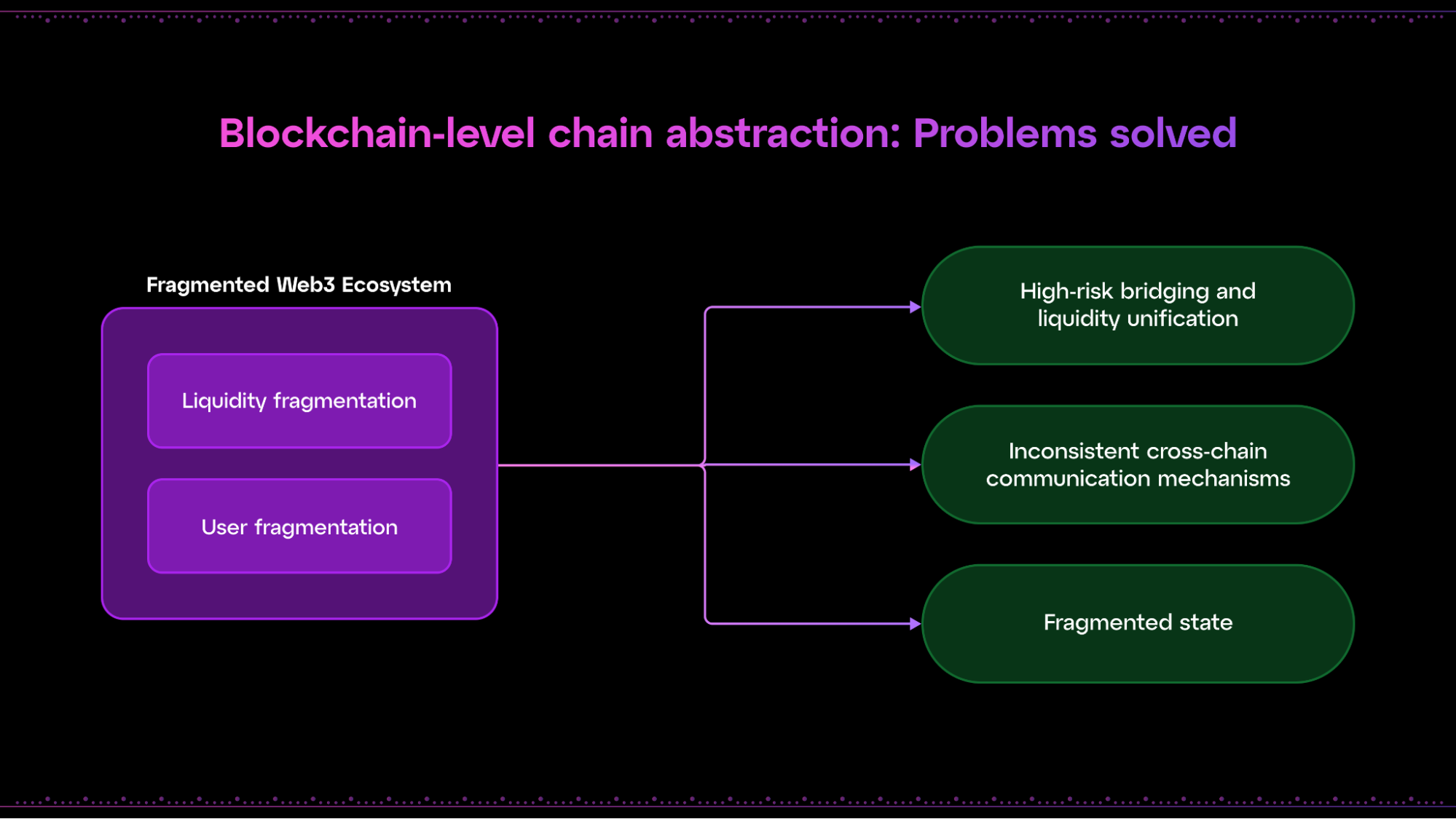
The blockchain layer primarily addresses the lack of infrastructure equality between individual blockchains, providing interoperability between them and creating a chain abstraction experience that minimizes risk, latency, and cost. It involves blockchains or collectives that share certain attributes, including:
Security mechanisms.
Cross-chain messaging and bridging capabilities.
Direct compatibility between chains with the same stack, allowing for high interoperability.
By sharing these characteristics, the blockchain layer achieves:
Easy migration or sharing of state between participating blockchains.
Providing security guarantees across collectives.
Efficient cross-chain messaging and communication.
While not a strict requirement for implementing chain abstraction, the blockchain layer significantly enhances the user experience by providing shared security, communication, and state management foundations for participating chains. This, in turn, can facilitate more efficient and seamless interactions at the account and application layers, enhancing their functionality and user experience.
Examples of implementations at the blockchain layer include Polygon's AggLayer, which aggregates zk-proofs obtained from a set of chains deployed through the Polygon stack and submits them for settlement on Ethereum. It also partially covers cross-chain messaging and interoperability using the Inter-Blockchain Communication (IBC) protocol in the Cosmos ecosystem. Optimism's superchain is also included in this layer.
Inapplicability
As mentioned above, projects or solutions that do not meet the initially specified criteria or explicitly attempt to implement any part of chain abstraction from a user experience perspective still hold value for the overall goals of chain abstraction.
These solutions may be more suitable for classification within Frontier Research's CAKE framework or Everclear's "Chain Abstraction Stack" as lower-level foundational solutions. These frameworks aim to cover the technologies, protocols, and primitives that make up chain abstraction solutions but do not directly address user experience aspects. Examples of such solutions include cross-chain messaging protocols, account abstraction primitives, settlement layers (such as Everclear), or intent-centric oracles (such as SEDA).
Specifically, the workings of these two frameworks are as follows:
CAKE Framework: Developed by Frontier Research, it is a low-level framework that organizes and unifies the various technologies and solutions that make up chain abstraction. It includes permission layers (account abstraction, intent, key management), resolution layers (cross-chain logic execution), and settlement layers (data availability layers, bridging, oracles).
Everclear's "Chain Abstraction Stack": It provides a low-level framework specifically for intent-centric chain abstraction implementations. It outlines the technology stack involved in enabling users to seamlessly execute cross-chain actions through a single interaction.
Both of these frameworks aim to provide a structured, granular understanding of the components and layers that make up chain abstraction solutions, but they differ in focus and scope. The CAKE framework takes a broader view of the technologies involved, while Everclear's stack is more focused on intent-centric solutions. The multi-layer framework operates at a much finer granularity than these frameworks, purely covering chain abstraction solutions rather than the technologies that compose them.
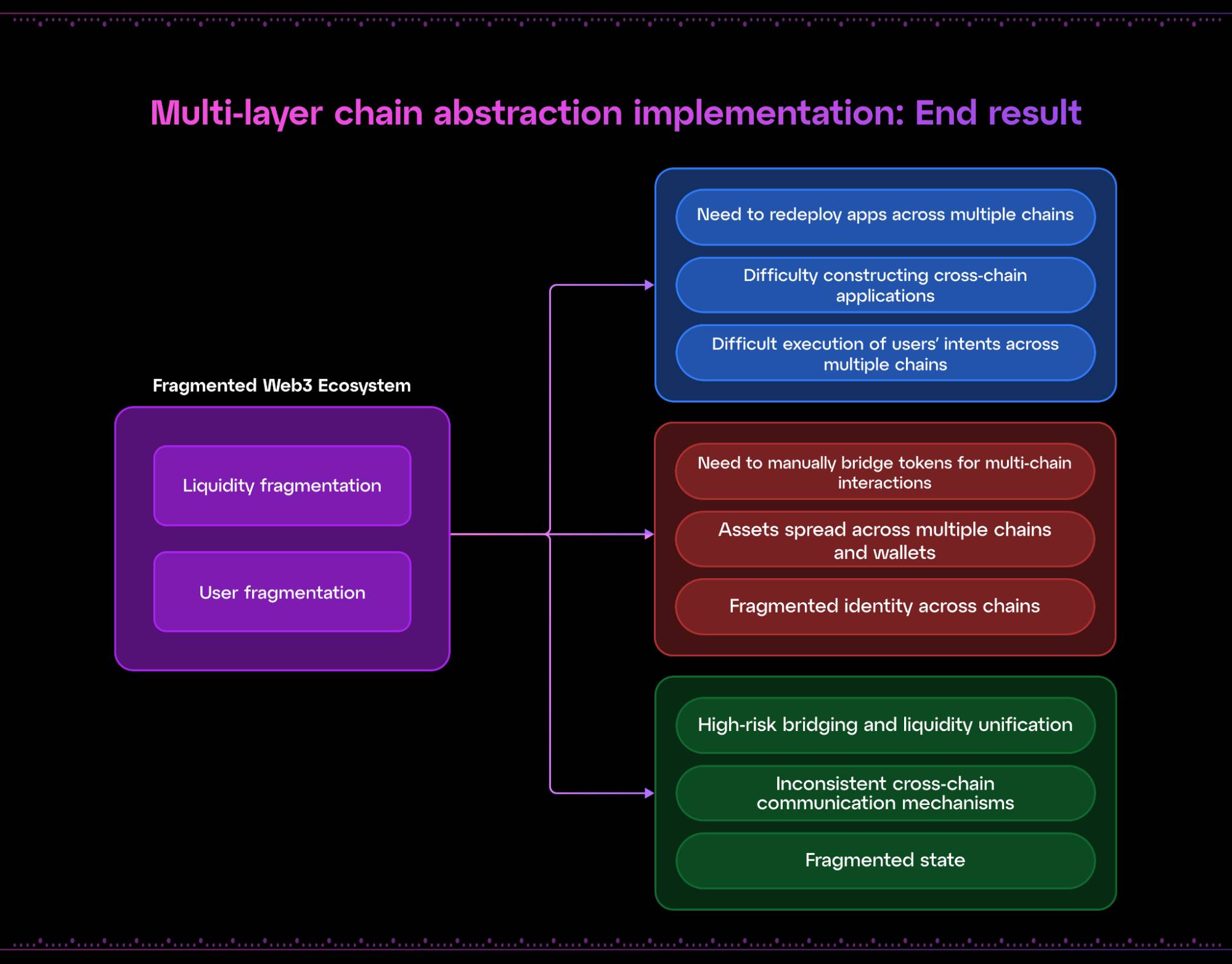
Conclusion
The multi-layer framework provides a new perspective for chain abstraction, classifying solutions based on their impact on user experience in the Web3 ecosystem. By differentiating abstractions at the blockchain layer, account layer, and application layer, it offers a structured approach to understanding the diverse and complementary roles of various chain abstraction technologies in achieving comprehensive implementation.
Industry participants can use this framework to strategically position their projects, identify potential collaboration opportunities, and guide product development. By understanding the position of their solutions within the multi-layer structure, teams can focus on enhancing specific aspects of chain abstraction while identifying opportunities for integrating complementary technologies.
This framework also provides a roadmap for investors and researchers to assess the completeness and potential impact of chain abstraction initiatives, ultimately driving towards a more unified and user-friendly Web3 ecosystem.
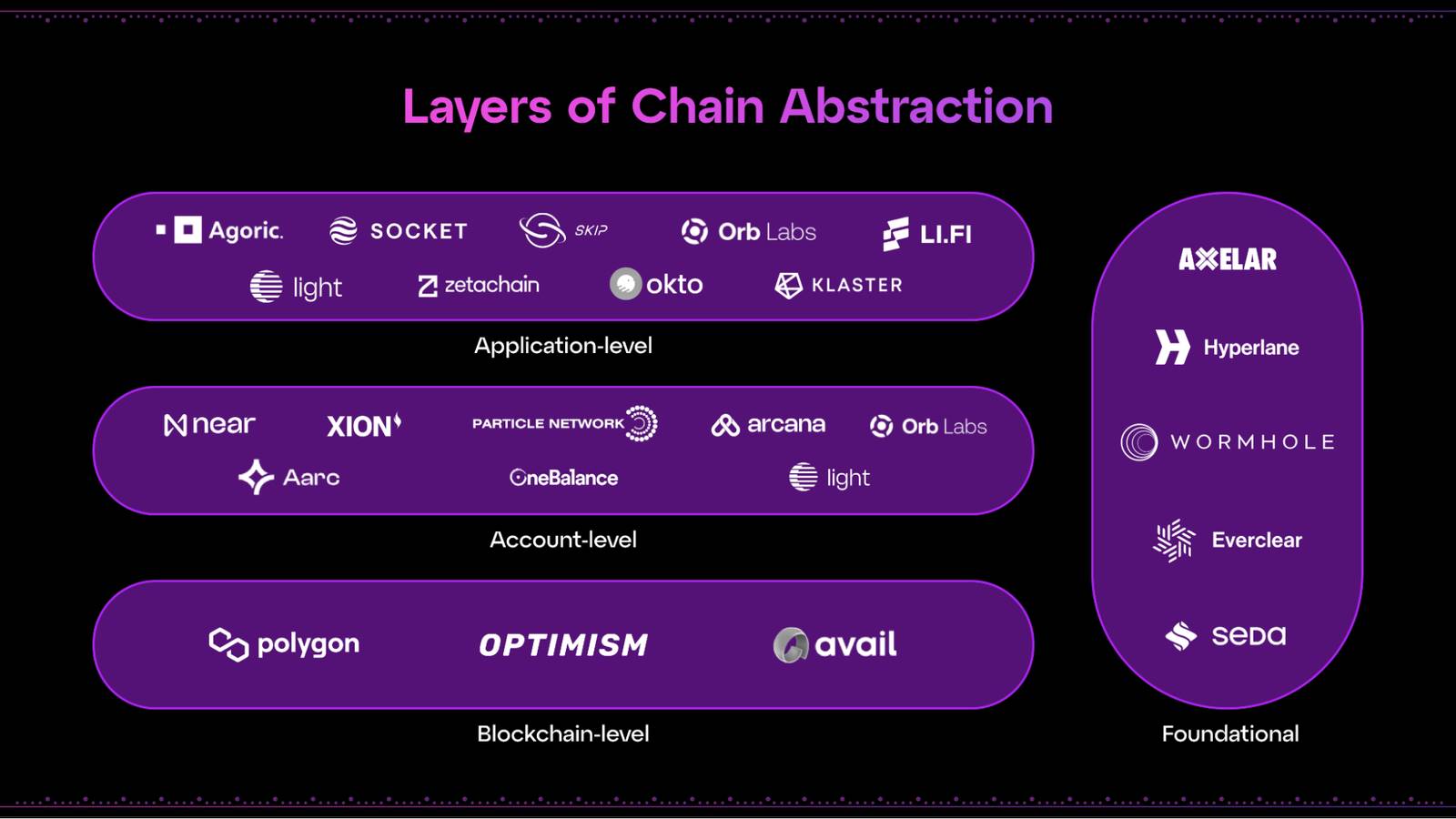
Join the official community of Deep Tide TechFlow
Telegram subscription group:
Official Twitter account:
English Twitter account:
免责声明:本文章仅代表作者个人观点,不代表本平台的立场和观点。本文章仅供信息分享,不构成对任何人的任何投资建议。用户与作者之间的任何争议,与本平台无关。如网页中刊载的文章或图片涉及侵权,请提供相关的权利证明和身份证明发送邮件到support@aicoin.com,本平台相关工作人员将会进行核查。




